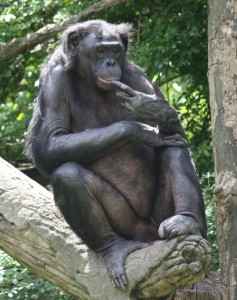Man is the Only Animal that Blushes. Or needs to.[1]
Right at the opening of the thirteenth chapter of The Expression of the Emotions in Man and Animals Charles Darwin wrote:
BLUSHING is the most peculiar and the most human of all expressions. Monkeys redden from passion, but it would require an overwhelming amount of evidence to make us believe that any animal could blush.[2]
Though Darwin affirmed that monkeys may redden from passion, he denied that they could blush in any human way. Maybe it comes as a surprise that even today, almost 150 years after Darwin stated the above-cited, human blushing remains quite mysterious. Concerning the human blush there are still many questions very open. In fact, the blush is ubiquitous yet scarcely understood.[3]
Recently, however, one age-old question concerning blushing – Do young women blush in the dark?[4] – was answered positively.[5] The essential apparatus used in this experiment was, of course, a thermographic camera.
Is blushing indeed the most human of all expressions? The present Question of the Week therefore becomes: Are there no other animals that blush? If we find one other blushing animal, then Darwin got it wrong. And likewise Frans de Waal, who wrote: ‘The only uniquely human expression, as Darwin already noted, is blushing. I don’t know of any instant face reddening in other primates.’[6]
The other animal most likely to blush – or most likely needing to blush – is arguably the bonobo. Thus remains the crucial problem: How to make a bonobo blush?
Bonobos prove to be societal and cultural animals. A great part of society and culture is concerned with morals. Morals always involve rules and boundaries. Breaking these rules and crossing these boundaries constitute a moral breach. In humans such a breach might produce a feeling of shame. According to Darwin blushing is associated predominantly with the feeling of shame. The test whether bonobos blush might consequently require (A) a naturalistic observation of one individual crossing a moral boundary while one or more others are present or (B) an artificial experiment in which one bonobo would be forced to commit a moral breach while being observed by other bonobos. The theoretical ground for this test has already been cleared: trichromatic primates can discriminate color changes in the skin of the face and the rump of conspecifics.[7] As bonobos may have more facial hair than humans and as their skin is rather dark blushing may not easily be noticed by a human observer. Here the aforementioned thermographic camera, already successful in solving one question, may come in handy again.
Wolter Seuntjens
References
[1] Mark Twain, Following the Equator – A Journey Around the World. Hartford, Connecticut: The American Publishing Company, 1897, p. 256 (motto Chapter 27 Pudd’nhead Wilson’s New Calendar).
[2] Charles Darwin, The Expression of the Emotions in Man and Animals. London: John Murray, 1872, p. 310. ( http://darwin-online.org.uk/content/frameset?pageseq=338&itemID=F1142&viewtype=side )
[3] W. Ray Crozier and Peter J. de Jong, The study of the blush: Darwin and after. In The Psychological Significance of the Blush. Cambridge: Cambridge University Press, 2013, p. 1. See also: David Huesmann, Why Do We Blush? Question of the Week, 09 September 2013 ( http://junq.info/?p=1959 )
[4] Georg Christoph Lichtenberg, Schriften und Briefe. Muenchen: Carl Hanser Verlag, 1971, vol. 2, p. 420 (K 115).
[5] Denise Waechter and Wolter Seuntjens, ‘Blushing in the Dark: First Experimental Proof’, Annals of Improbable Research vol. 9, no. 2, March-April 2013, pp. 6-7. ( http://www.improbable.com/airchives/paperair/volume19/v19i2/BlushingInTheDark19-2.pdf )
[6] Frans de Waal, The Bonobo and the Atheist: In Search of Humanism Among the Primates. New York: W. W. Norton, 2013, p. 155.
[7] Mark A. Changizi, Qiong Zhang, and Shinsuke Shimojo, ‘Bare skin, blood and the evolution of primate colour vision’, Biol Lett. 2006 June 22; 2(2): 217–21. ( http://rsbl.royalsocietypublishing.org/content/2/2/217.full )
